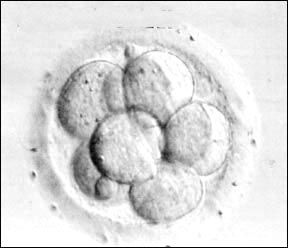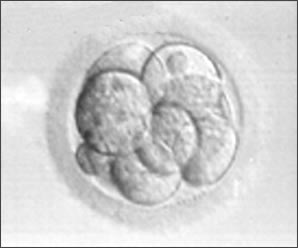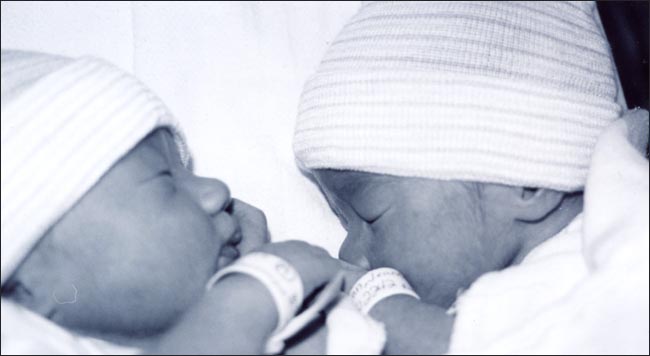인공 수정, Artificial fertilization
- 수정이 남녀가 성교해서 자연적으로 되는 것이 아니라 수정을 인공적으로 시키는 것을 인공수정이라 한다.
- 결혼한 대부분의 부부들은 성교를 하고, 성교를 한 후 남편의 정자와 부인의 난자가 난관 속에서 만나 자연적으로 수정되고 그리고 임신이 성립된다.
- 수정란이 자라 배아가 되고 그 배아가 자라 태아가 되고 태아가 자라서 아기가 태어난다.
- 일부의 부부들에게는 여러 가지 원인으로 인해 수정이 되지 않고 물론 임신도 될 수 없다.
- 이런 현상을 불임이라 한다.
- 임신을 할 수 없는 여러 가지 원인들 중 가장 흔한 원인은 부인의 난관이 어떤 이유로 막혀 난소에서 나온 난자와 남성의 고환에서 나온 정자가 서로 만날 수 없어 수정이 되지 않는 것이다.
- 다른 불임의 원인은 남편의 정자의 수가 임신될 수 없을 정도로 충분치 않기 때문이다. 그 외로 임신이 되지 않는 이유가 많다.
- 임신되지 않으면 부부는 의사의 정밀한 진찰 진단을 받아야 한다.
- 난관이 막혔으면 막힌 난관의 부분이 소통되게 하는 난관 소통 수술을 받을 수 있다.
- 남편의 정자수가 비정상으로 적어 임신이 되지 않으면 남편의 정자를 모아 정자들을 부인의 자궁 속에 직접 주입해서 임신되게 하는 방법도 있다.
- 이 방법으로 수정시키는 것도 일종의 인공수정이다.
- 어떤 남편들은 정자를 전혀 만들 수 없다. 그런 때는 남편이 사정한 정액 속에 정자가 하나도 없다. 이런 경우, 부인이 임신될 수 없다.
- 드물게는 남성이 만드는 정자의 수는 충분하지만 그 정자들이 비정상적 정자들일 수 있다. 이런 부부의 경우 정상적인 난자와 비정상적인 정자가 만나서 수정이 될 수 없고 임신도 되지 않는다. 이런 경우도 다른 남성의 정자를 얻어 튜브를 통해서 다른 남자의 정자를 부인의 자궁 속에 인공으로 넣어서 아기를 배게 할 수 있는 인공수정 방법도 있다.
- 부인이 난자를 만들어 낼 수 없어 아기를 밸 수 없으면 남편의 정자를 다른 여성의 난자와 테스트 튜브 속에서 인공으로 수정시킨 다음 그 수정란을 자기 부인 자궁 속에 넣어서 자기 부인의 자궁 속에서 아기가 자라게 해서 아기를 낳을 수도 있는 인공수정 방법도 있다.
- 때로는 남편의 정자와 부인의 난자를 시험관 속에서 수정시킨 후 그 수정란을 부인의 자궁에 넣어 임신시킬 수 있다. 이런 임신을 시험관 임신이라고 한다.
- 부모도 반의사가 되어야 한다-소아가정간호백과]-제 3권 신생아, 영유아, 학령기아, 사춘기아 성장발육육아. 제 10권 소아청소년 비뇨 생식기계 질환. 제 14권 소아청소년 내분비 유전, 염색체 대사, 희귀병. 제 25권 임신, 분만, 출산, 신생아 돌보기-진통이 시작된다. 참조.

그림 10-20. 시험관 속에서 수정된 후 수정란이 세포분열을 일으켜 생긴 상실 배.
임신시키기 위해 자궁 속에 넣기 바로 전 단계
사진 상실배가 자라서 다음 사진에서 볼 수 있는 아기로 태어났다. (저자의 손자손녀)
Amazing ! Amazing !… Wonderful ! Wonderful !.. God Bless!.
Copyrightⓒ 2001 John Sangwon Lee,MD.,FAAP

그림 10-21. 시험관 속에서 수정된 후 수정란이 세포분열을 일으켜 생긴 상실 배.
임신시키기 위해 자궁 속에 넣기 바로 전 단계
이 상실배가 자라서 다음 사진에서 볼 수 있는 아기로 태어났다.(저자의 손자 손녀)
Amazing! Amazing !… Wonderful! Wonderful !.. God Bless!.
Copyrightⓒ 2001 John Sangwon Lee, MD., FAAP

그림 10-22. 시험관 수정란은 엄마의 자궁 속에 넣어 자궁에서 자라고 태어난 이란성 쌍생아의 생후 2시간. 출처-Copyrightⓒ 2001 John Sangwon Lee, MD. FAAP
Artificial fertilization
• Artificial insemination refers to artificial insemination rather than natural fertilization through sexual intercourse between a man and a woman.
• Most married couples have sexual intercourse, and after sexual intercourse, the husband’s sperm and the wife’s egg meet in the fallopian tube for natural fertilization and pregnancy.
• A fertilized egg grows into an embryo, and the embryo grows into a fetus, and the fetus grows and a baby is born. • For some couples, for a variety of reasons, fertilization and, of course, infertility are not possible.
• This phenomenon is called infertility.
• Among the various causes of infertility, the most common cause is that the woman’s fallopian tubes are blocked for some reason and the egg from the ovary and the sperm from the man’s testes cannot meet, so fertilization is not possible.
• Another cause of infertility is that the husband doesn’t have enough sperm to become pregnant. There are many other reasons for not getting pregnant.
• If pregnancy does not occur, the couple should undergo a thorough examination by a doctor.
• If the fallopian tube is blocked, you may have a fallopian tube communication surgery that allows the part of the fallopian tube to communicate.
• If the husband’s sperm count is abnormally low and pregnancy does not occur, there is a method to collect the husband’s sperm and inject the sperm directly into the wife’s womb to become pregnant.
• Insemination in this way is also a kind of artificial insemination.
• Some husbands cannot make sperm at all. At that time, there is no sperm in the semen ejaculated by the husband. In this case, the wife cannot become pregnant. • Rarely, a man makes enough sperm, but the sperm may be abnormal.
In such a couple, a normal egg and an abnormal sperm meet, so fertilization cannot be achieved and pregnancy is not possible. In this case, there is also an artificial insemination method that can get another man’s sperm and put the other man’s sperm through a tube into the wife’s womb, so that the baby can be born.
• If a woman cannot produce an egg and cannot deliver a baby, the husband’s sperm is artificially fertilized with another woman’s egg in a test tube, and then the fertilized egg is placed in the womb of the wife and the baby grows in her womb. There are also artificial insemination methods that can give birth to babies.
• Sometimes the husband’s sperm and the wife’s egg are fertilized in vitro and then the fertilized egg is placed in the wife’s womb to get pregnant. This pregnancy is called an in vitro pregnancy.
• www.drleepediatrics.com – Volume 3 Newborns, infants, school-age children, adolescents, growth and development. Volume10: Diseases of the genitourinary system in children and adolescents. Volume 14: Endocrine inheritance in children and adolescents, chromosomal metabolism, and rare diseases. Volume 25 Pregnancy, delivery, childbirth, and caring for a newborn baby – labor begins. Reference.

Figure 10-20. A morula formed by the cell division of a fertilized egg after fertilization in vitro. Just before being placed in the womb to get pregnant Photo The louse grew up and was born as the baby you can see in the next photo. (grandchildren of the author) Amazing! Amazing !… Wonderful! Wonderful !.. God Bless!. Copyrightⓒ 2001 John Sangwon Lee, MD., FAAP

Figure 10-21. A morula formed by cell division of a fertilized egg after fertilization in vitro. Just before being placed in the womb to get pregnant This mother-in-law grew up and was born as the baby you can see in the next photo. (Author’s granddaughter) Amazing! Amazing !… Wonderful! Wonderful !..
God Bless!. Copyright© 2001 John Sangwon Lee, MD., FAAP

Figure 10-22. An in vitro fertilized egg is placed in the mother’s womb and grown in the uterus for 2 hours after birth of fraternal twins. Source-Copyrightⓒ 2001 John Sangwon Lee, MD. FAAP
출처 및 참조 문헌 Sources and references
- NelsonTextbook of Pediatrics 22ND Ed
- The Harriet Lane Handbook 22ND Ed
- Growth and development of the children
- Red Book 32nd Ed 2021-2024
- Neonatal Resuscitation, American Academy of Pediatrics
-
The Johns Hopkins Hospital, The Harriet Lane Handbook, 22nd edition
-
Red book 31st edition 2021
-
Nelson Text Book of Pediatrics 21st Edition
-
Emergency Pediatrics A Guide to Ambulatory Care, Roger M. Barkin, Peter Rosen
-
Ambulatory Pediatrics, Green and Haggerty, Saunders
-
School Health: A Guide For Health Professionals, American Academy of Pediatrics
-
How to really love your child Ross Campbell
-
Good Behavior Stephen W. Garber, Ph.D. and other
-
Adolescent Medicine and The Media Adolescents Medicine
-
AM: Stars Adolescent Medicine: State of the Art Reviews, Asthma, and Diabetes in A
-
The Pediatric Clinics of North America, Adolescent Gynecology, Part II THe Sexually Active Adolescent, August 1999
-
Fueling the Teen Machine, Ellen Shanley and Colleen Thompson
-
Why Teenagers Act the Way They Do, Eight Adolescent Personality Types: Understanding and Dealing With Them, Dr. G. Keith Olson
-
The Pregnancy bible Joan Stone, Keith Eddleman
-
Pediatric and Adolescent Endocrinology, The Pediatric Clinics of North America in August 1987
-
Adolescent Gynecology, Ross Round table
-
Female Reproductive Health, Adolescent Medicine Patricia S. Simmons, M.D., Marc. Laufer, M.D.
-
The Adolescent Male: Adolescent Medicine, David S. Rosen, M.P.H., Michael Rich, M.D.
-
Lesbian and Gay Youth: Care And Counseling, Adolescent Medicine, Caitlin Ryan, M.S.W, A.C.S.W., Donna Futterman, M.D.
-
Medical and Gynecologic Endocrinology: Joseph S. Sanfilippo, M.D., Jordan W. Finkelstein, M.D., Dennis M. Styne. M.D., Adolescent Medicine Clinics, Oct. 2005 Vol. 16
-
Robert T. Brown, M.D., Paula K. Braverman, M.D.
-
진정한 자녀 사랑 나비게이터
-
10대 아들 딸 이렇게 사랑해 키워라 이상원 역
-
소아과학 대한교과서
-
의학 용어사전 대한 의사 협회
-
제24권 사춘기 성교육 출처 참조 문헌
- Gray Anatomy
- 제 25권 임신, 분만, 출산, 신생아 돌보기 이상원저
-
그 외
Copyright ⓒ 2014 John Sangwon Lee, MD., FAAP
“부모도 반의사가 되어야 한다”-내용은 여러분들의 의사로부터 얻은 정보와 진료를 대신할 수 없습니다.
“The information contained in this publication should not be used as a substitute for the medical care and advice of your doctor. There may be variations in treatment that your doctor may recommend based on individual facts and circumstances.
“Parental education is the best medicine.“